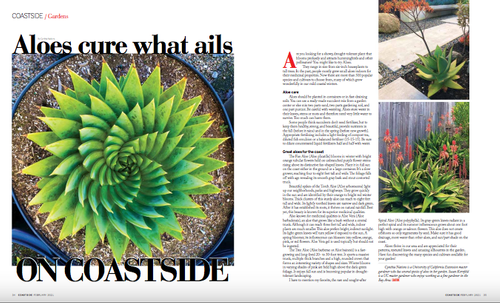Are you looking for a showy, drought tolerant plant that blooms profusely and attracts hummingbirds and other pollinators? You might like to try Aloes! They range in size from six-inch houseplants to tall trees. In the past, people mostly grew small aloes indoors for their medicinal properties. Now there are more than 500 popular species and cultivars to choose from, many of which grow wonderfully in our mild coastal winters.
Aloe Care
Aloes should be planted in containers or in fast-draining soils. You can use a ready-made succulent mix from a garden center or else mix two parts sand, two parts gardening soil, and one part pumice. Be careful with watering. Aloes store water in their leaves, stems, or roots and therefore need very little water to survive. Too much can harm them.
Some people think succulents don't need fertilizer, but to keep them healthy, strong, and beautiful, provide nutrients in the fall (before it rains) and in the spring (before new growth). Appropriate fertilizing includes a light feeding of compost tea, diluted fish emulsion, or a balanced fertilizer (15-15-15). Be sure to dilute concentrated liquid fertilizers half and half with water.
Great Aloes for the Coast
The Fan Aloe (Aloe plicatilis) blooms in winter with bright orange tubular flowers held on unbranched purple flower stems rising above its distinctive fan-shaped leaves. Plant it in full sun on the coast either in the ground or a large container. It's a slow grower, reaching 4-8 feet tall and wide. The foliage falls off with age revealing its smooth gray bark and stout contorted truck.
Beautiful spikes of the Torch Aloe (Aloe arborescens) light up our neighborhoods, parks, and highways. They grow quickly in the sun and are identified by their orange to bright red winter blooms. Thick clusters of this sturdy Aloe can reach to 8 feet tall and wide. Its lightly-toothed leaves are narrow and dark green. After it has established its roots, it thrives on natural rainfall. Best yet, this beauty is known for its superior medicinal qualities.
Also known for medicinal qualities is Aloe Vera (Aloe Barbadensis), an aloe that grows like a bush without a central trunk. Although it can reach 3 feet tall and wide, indoor plants are much smaller. This aloe prefers bright, indirect sunlight. Its light-green leaves will turn yellow if exposed to the sun. A spring bloomer, its inflorescence can blossom into yellow, orange, pink, or red flowers. Aloe Vera gel is used topically but should not be ingested.
The Tree Aloe (Aloe barberae or Aloe bainesii) is a fast-growing and long-lived 20–30-foot tree. It sports a massive trunk, multiple thick branches, and a high rounded crown that forms an interesting variety of shapes and sizes. Winter blooms in varying shades of pink are held high above the dark-green foliage. It enjoys full sun and is becoming popular in drought-tolerant landscaping.
I have to mention my favorite, the rare and sought-after Spiral Aloe (Aloe polyphylla). Its gray-green leaves radiate in a perfect spiral, and its summer inflorescence grows about one foot high with orange or salmon flowers. This Aloe does not create offshoots so only regenerates by seed. Make sure it has good drainage, more water than other Aloes, and sun/part shade on the coast.
Aloes thrive in our area and are appreciated for their patterns, textured leaves, and amazing silhouettes in the garden. Have fun discovering the many species and cultivars available for your garden!
Cynthia Nations is a UC Master Gardener who has several species of Aloes in her garden. Susan Kornfeld is a UC Master Gardener who enjoys working as a fine gardener in the Bay Area.
Attached Images:
